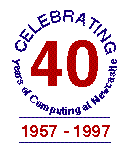

|
Student Registration by ComputerElizabeth Barraclough |
The most time consuming task was providing a list in alphabetical order of all the students registered for courses in the College - at this time, 1959, Kings College Newcastle was part of Durham University and had about 4,500 students.
The task was simple, all we needed to do was create a record for each student giving details of name, course, year etc, sort these into alpha order and provide a printed list. However, despite its physical size, the machine configuration was not entirely suited to the task. We had 39 bit registers (or words), 56 words of high speed store, 4096 words of backing store, no magnetic tape, two paper tape readers, one paper tape punch and a Teleprinter. The plan was to create a record for each student on paper tape, read as large a batch into the computer as it could manage, sort these into alpha order (an early application of binary search trees) and output onto punched paper tape, continue in this way until we had N (about 24) paper tapes containing student records in alpha order. The next step was to read two paper tapes, merge these to create a single paper tape containing twice as many student records. The tape readers were fast, 200 characters per second, the punch was not as fast, 33 cps. In total we had to read and punch the complete student list 5 times at about two hours each pass. It had to be done overnight and even then we still had the task of printing the list at 7 cps! Absolutely straightforward with the splendid team we had from the Director upwards in competence. All would be fine provided you didn't lose your nerve, tread on the tape, fall asleep, pick up the wrong tapes, spill coffee, and the machine kept going. Nearly all these mini disasters happened, it would be churlish to point a finger at the culprits after this lapse of time. Suffice it to say that at one point the operator was found asleep at the controls in the midst of a sea of yellow tape.
By the following year magnetic tape units were installed and the alpha list and faculty lists were produced each year on a regular basis.
I was foolhardy enough to take Harry's suggestion seriously and said yes; astonishingly, Harry was foolhardy enough to take me seriously as well. The transaction was committed and there was 'no turning back'. Harry, Dick Snow and the Arjuna team (in particular, Mark Little, Stuart Wheater and Dave Ingham) plunged into designing the application that is described in all its gory details in a technical paper.
Although September-October of 1994 was a rather nerve racking time for us, I am happy to say we came out with our reputations unblemished; the system worked vey well, surviving workstation crashes without noticable hiccups. About 100 front end machines (PCs, MACs) scattered all over the campus make use of 8 to 10 Unix workstations that run the Arjuna transactional application that manages student records. Now this system is in its fourth year; it was used to register in excess of 12000 students during the one week period immediately prior to the start of this term.
Photographs of student registration 1996.